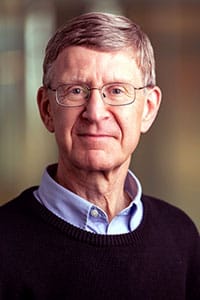COVID 19 may have tested humanity’s strength over the past 18 months, but a group of 5th grade students at Notre Dame School of Milwaukee is discovering that the science of virology can be a new superpower.
The students are among the first users of a new digital learning resource developed by PBS Wisconsin called “Meet the Lab,” which gives middle school-aged students a glimpse into high-powered research labs and the scientists who run them. The resource debuting in fall 2021 features the work of the John W. and Jeanne M. Rowe Center for Virology Research at the Morgridge Institute for Research.
The modules are designed to plug into regular middle school sciences classes and give students a deeper appreciation of how research impacts our lives. For “Virus Investigators,” that begins with a video featuring Madison firefighter and EMT Adam Perez, who describes how the COVID 19 pandemic affected every corner of his professional and personal life.
Then the program shifts to UW–Madison professor and Morgridge Investigator Paul Ahlquist and his team, who describe the tools of virology, what questions motivate them and their own “superpowers,” like perseverance, curiosity and risk-taking. The last element is an in-depth activity where students get to search for viral particles inside an infected cell and figure out how the virus replicates itself.
Kathy Biernat, Grades 5-8 science teacher at Notre Dame, used Virus Investigators on November 3 with her 5th grade students, and she says she noticed impressive before-and-after results about what the students knew about viruses.
“Prior to this, talking about COVID was really relegated to prevention — six feet apart, masks, etc. — and not really on how the virus works,” Biernat says. “So, yesterday we talked about how it actually is affecting the cell. They knew it affected the body — they mostly thought the lungs — but by the end, they realized that the reason people get sick is because of the damage to the cell, but more importantly because viruses use the energy of the cell to replicate.”

The scientists describe their research in highly relatable ways. For example, virologist Nuruddin Unchwaniwala says viruses attack cells like an unwanted guest pushing into your home, eating your food, using the bathroom and generally trashing the place. Scientist Megan Bracken describes microscopy as a pathway to an “invisible world.”
“It’s like a tiny parallel universe that is existing alongside us or even inside of us,” Bracken says.
Biernat says that’s the real superpower of the project. “This resource gave students a way to visualize what we cannot see,” she says. “And instead of just saying viruses are ‘really small,’ they compared it to trying to find an M&M on a football field, making it something students could relate to.”
“For my students, hearing from the researchers helped them to see that the reason we are beginning to understand the coronavirus is because of people — real people, in real labs.”
Kathy Biernat
Biernat is not only a Meet the Lab user; she is a member of the six-member teacher cohort that helped vet the content to make sure it meets middle school standards. The teachers all met with the participating scientists and Biernat says teacher input led to many changes in the final product.
“For my students, hearing from the researchers helped them to see that the reason we are beginning to understand the coronavirus is because of people — real people, in real labs,” she says.
Ahlquist says the project really has two-way benefits, since translating their group’s research for non-scientist audiences really forces them to consider what matters most to the general public. “It challenges us to think about what’s fundamentally important about what we’re doing. At some level, it gets us to reevaluate the priorities we should have.”

Ahlquist was reminded of a scientific address given by Eric Lander – today the National Director of Science Policy for President Biden — where Lander had just come from a presentation to high school students. Lander decided to use the same slides with scientists that he did with high schoolers.
“And I’m sure he went into more depth, but the common point is that the communication issues are largely the same: What is important? Why is it important? And what can be done about it?”
Alyssa Tsagong, Director of Education for PBS Wisconsin, says the Meet the Lab project came about in 2019 thanks to the generous support of the Timothy William Trout Education Fund. The virus project is just one of four modules completed, all focusing on the science taking place at Morgridge and the Wisconsin Institute for Discovery. Other modules feature data science, antibiotics, cancer detection and the nervous system.
“It has been an honor to witness the sparks that emerge when middle school educators and scientists collaborate,” Tsagong says. “Bringing the stories and practices of the science behind virus research that is happening right here in Wisconsin helps learners find meaning and relevance in their schoolwork. Meaning and relevance lead to attention, and to authentic learning outcomes.”
